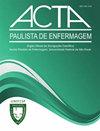Burnout, COVID-19, social support and food insecurity in health workers
IF 1.1
4区 医学
Q3 NURSING
引用次数: 0
Abstract
Objective: To evaluate the prevalence of risk for Burnout Syndrome among health professionals in areas of care for patients with COVID-19, as well as to verify possible associations of the syndrome with the perceived social support and food insecurity of these workers. Methods: Analytical cross-sectional study, with workers from intensive care units (ICU) and wards caring for patients with COVID-19, in a university hospital. Data collection was carried out from September to October 2021, using the instruments: Maslach Burnout Inventory (MBI-HSS), Multidimensional Perceived Social Support Scale and Food Insecurity Experience Scale (FIES). Statistical analysis used Poisson regression models and multiple Poisson regression, considering statistically significant differences and associations if p<0.05. Results: A total of 75 workers from three wards (48%) and from one ICU (52%) participated in the survey, and the professionals are mostly female (89.3%), trained as health care technicians (66.7%). Regarding the risk of Burnout Syndrome, 26.7% of the workers had scores for at least one dimension of the scale, mainly referring to high emotional exhaustion (20%). There was a positive association between the risk of developing Burnout Syndrome and food insecurity (PR = 1.11; 95%CI = (1.04; 1.18); p = 0.002). The number of children was significantly negatively associated with the incidence of Burnout Syndrome (PR = 0.90; 95%CI = (0.83; 0.97); p = 0.008). Conclusion: Positive associations were observed with a higher risk of BS in professionals with food insecurity and also that the number of children acts as a protective factor against the risk of Burnout Syndrome, which may be directly related to perceived social support.卫生工作者的职业倦怠、COVID-19、社会支持和粮食不安全
目的:评估COVID-19患者护理领域卫生专业人员职业倦怠综合征的患病率,并验证该综合征与这些工作人员感知到的社会支持和食物不安全之间的可能关联。方法:对某大学医院重症监护病房(ICU)和病房的COVID-19患者进行分析性横断面研究。数据收集于2021年9月至10月进行,使用的工具包括:Maslach倦怠量表(MBI-HSS)、多维感知社会支持量表和粮食不安全体验量表(FIES)。统计学分析采用泊松回归模型和多元泊松回归,如果p<0.05,考虑差异和关联具有统计学意义。结果:共有来自3个病区(48%)和1个ICU(52%)的75名工作人员参与调查,专业人员以女性居多(89.3%),受过卫生技术人员培训(66.7%)。在倦怠综合症的风险方面,26.7%的员工在量表中至少有一个维度得分,主要是指高情绪耗竭(20%)。发生职业倦怠综合征的风险与食物不安全之间存在正相关(PR = 1.11;95%ci = 1.04;1.18);P = 0.002)。儿童人数与倦怠综合征发生率呈显著负相关(PR = 0.90;95%ci = 0.83;0.97);P = 0.008)。结论:食物不安全的专业人员的BS风险较高,并且孩子的数量是防止倦怠综合征风险的保护因素,这可能与感知到的社会支持直接相关。
本文章由计算机程序翻译,如有差异,请以英文原文为准。
求助全文
约1分钟内获得全文
求助全文
来源期刊

Acta Paulista De Enfermagem
NURSING-
CiteScore
1.40
自引率
0.00%
发文量
92
审稿时长
4 weeks
期刊介绍:
Acta Paulista de Enfermagem – (Acta Paul Enferm.), ISSN 1982-0194, is a [bilingual] technical-scientific electronic publication of the Escola Paulista de Enfermagem – EPE, Universidade Federal de São Paulo – UNIFESP.
Our mission: To disseminate the scientific knowledge generated within the rigor of research and ethics methodology.
Our objective: To publish results of original research for advancement of practices of clinical, surgical, and management nursing, as well as education, research, and information and communication technology.
 求助内容:
求助内容: 应助结果提醒方式:
应助结果提醒方式:


